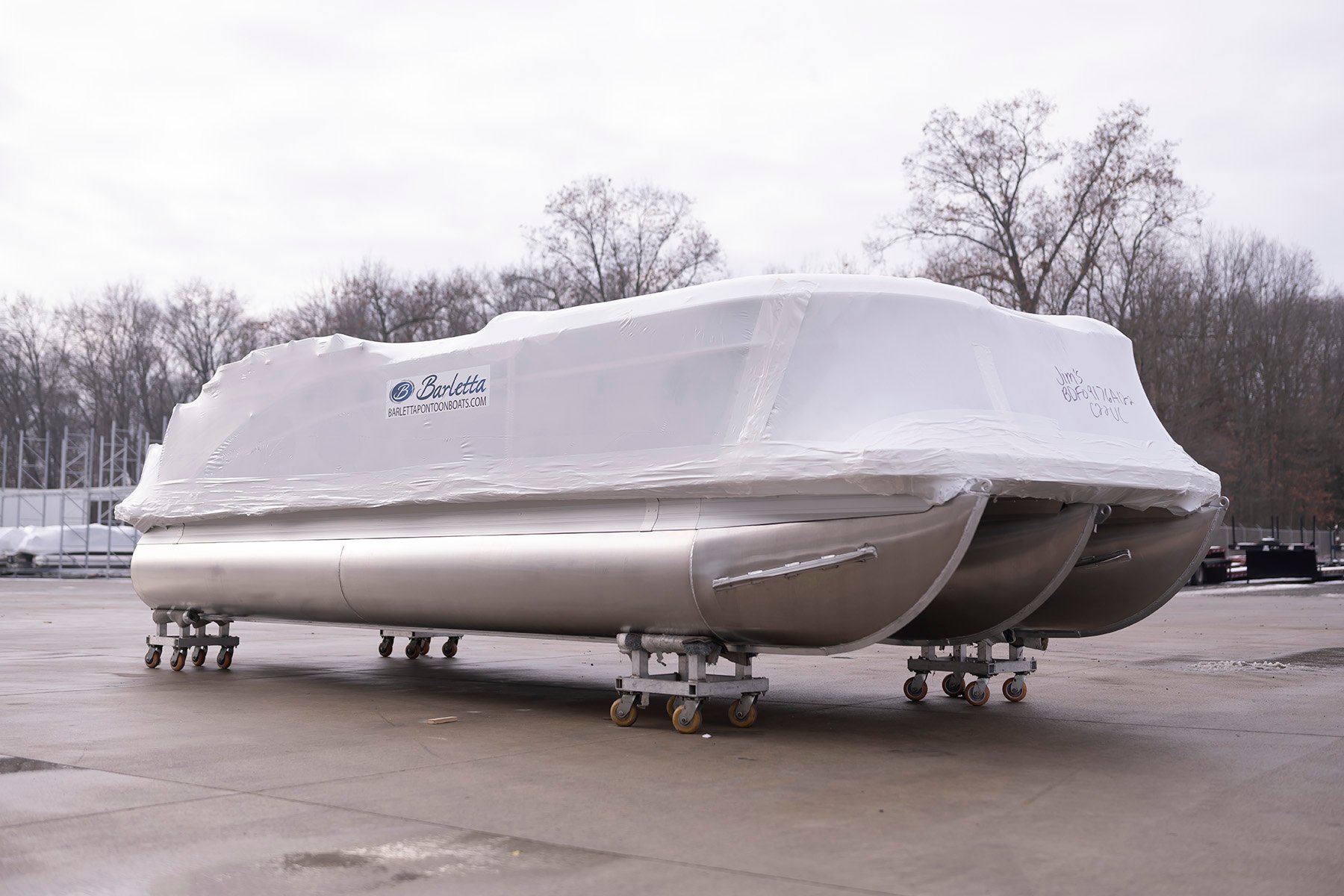How to Winterize a Pontoon Boat (6 Easy Steps)
So you’ve just bought your first pontoon boat. You kicked off boating season with a new ride and it’s everything you could have hoped for in a boat. The family is comfortable, everyone has their own spot to kick back while you cruise.
Summers have never been better than this. The pontoon boat handles like a dream, maintenance is easy and everyone is happy. As the leaves start turning and a chill enters the air, you should be thinking about what needs to happen once boating season ends.
Are you prepared to winterize your boat? Do you know how and who will handle this process? Planning ahead for this next step will make winterizing your pontoon boat quick and easy. But where should you start?
As a long time pontoon boat owner, I have this nailed down to a science. I take care of part of the process and leave the more important items, like winterizing the engine, to my dealership. Prepping the motor is the most critical step in winterizing the boat.
That said, if you’ve never laid eyes on an engine or never had grease on your hands, take after me and have your dealer handle it. They are the experts and will be happy to connect you with their service department to make an appointment at the end of the season.
If you’re engine savvy, know all about outboard motors, and are confident that you can handle the winterization process, I’m going to give you some general direction on how this should be done.
I cannot stress this enough, proceed at your own risk. No one is liable for engine failure due to a bad winterization job except for you. There are other steps in the process you can handle that are not as detrimental as caring for the motor, so take what you want from this article and leave the rest to the experts.
1. Remove the boat from the water
2. Clean the exterior
3. Clean the interior
4. Winterize the engine
5. Keep the battery charged
6. Store the boat
1. Remove the Boat from the Water
In areas where the weather turns cold, nearly everyone pulls their pontoon out of the water using a boat trailer. In warmer climates, you may see people who keep their boat on a lift high up out of the water all winter long and winterize without pulling it completely.
The majority will pull the boat completely out of the water using a trailer they own, borrow or rent. Some will even have their dealer handle the whole process from pulling the boat, winterizing and storing it.
For those who are tackling this entire procedure themselves, pulling the pontoon boat out will require at least two people, a trailer, and tow vehicle. Once the boat is out of the water, it’s time to close up shop.
2. Clean the Exterior
My very first step when pulling the pontoon out is to scrub down the toons. It’s much easier to clear off discoloration and marine growth while it’s still wet. You can go about this a couple of ways, using a pressure washer or a soft bristle brush.
Pressure washing of the toons can be done whether the toons have a ceramic coating such as Metal Jacket or not, and this is highly recommended if they are badly fouled. Toons that do not have a coating on them can be acid washed but should be done by an experienced dealer.
A soft bristle brush and soapy water can also help if you’re up for hand scrubbing the toons. Something that’s a bit surprising is that a build-up of marine growth on the toons can decrease the speed you get out of your engine.
Soapy water and a soft cloth will be the ticket to clean down side panels and rails. Getting all the grime off that has collected over the summer will make it that much easier to clean the following season.
You might also check the motor and propeller to clean off any remaining seaweed or marine growth that has collected in all the little nooks and crannies. Making sure any screens or vents on the engine are clear of debris will also be conducive to its performance the following season.
[Learn more about performance hindrances in our article What is Wrong with My Pontoon Boat Motor?]
3. Clean the Interior
Don’t put your scrub brush away just yet. Cleaning the interior of your pontoon boat before you put it away is just as important as cleaning the exterior. One of the first things I do is take out all life jackets, towels and boat accessories so that I have easy access to cleaning the furniture and storage compartments.
Once the furniture is empty, you can clean the seats and the storage underneath the seats with mild soap and water. After they’re cleaned up, leave the seats open for a bit and let the storage underneath air out. If you close up the boat while it’s still damp, you run the risk of mold and mildew growing while in storage.
Make sure you clean the seats well enough and there’s not any wet leaves left behind. This can be detrimental as the wet leaves can stain the furniture if left too long. Keeping the furniture clean will extend its lifespan.
You also want to make sure and remove any trash left behind in the boat. You don’t want to leave any reason for a rodent to find their way to your pontoon boat and make a nice cozy home in the furniture. I’ve seen this happen too many times and the damage done takes a pretty penny to repair.
Lastly, clean the flooring and remove any crumbs left behind. You can start with a broom or leaf blower to remove the big stuff like leaves and debris. A shop vac will also come in handy here especially to get in those tight corners around the rails.
Depending on the type of flooring you have, you might also be able to hose down the floor or use soap and water to do a final cleanup. Just make sure you let the carpet dry before covering it for the winter, as I mentioned before, a damp boat can lead to mildew.
4. Winterize the Engine
Alright, we’ve come to the hard part. As I mentioned before, I leave the engine winterizing to the experts. Do not attempt this if you’re not mechanically inclined. It’s not worth destroying your motor. But if you’re handy and capable of this type of challenge, here are some tips.
It’s important to get all of the water out of your motor so you don’t encounter frozen water damaging the internals. Outboard engines are self-draining, so they will drain any water out of the block and exhaust when tilted down in the vertical position. This is how the motor should be tilted while in storage.
That said, the engine should be run on a water hose prior to storing to make sure there aren’t any obstructions in the system. There is a connection point on the lower unit for a hose to connect. Watch for a stream of water exiting the “Tell-Tale.”
The fuel tank should also have the appropriate amount of fuel stabilizer added prior to the engine being run on the hose. This allows the stabilizer to run through the fuel system in the engine and will prevent any gumming or deposits in the spring. The lower unit oil should also be changed at this time.
Most dealers use winterization as an opportunity to perform annual maintenance items such as changing the engine oil and filter, anodes, greasing the propshaft, water pump impeller, and others.
Something else to consider, if there has been a seal failure on the propshaft from a tangled up fishing line and water has entered the lower unit, it needs to be drained and refilled to prevent freezing and cracking of the housing.
There are many components on the motor that need tending to in order to properly winterize it. That’s why I say if you’re not up for the task, call your dealer. You’ll be glad you did when summer rolls around and your boat is running smoothly.
5. Keep the Battery Charged
Whether the batteries stay inside the boat or not, it’s very important to store the battery with a full charge. A low battery can freeze and become damaged in the cold. Either way, disconnect the battery or batteries and make sure they stay charged.
The best way to store batteries is in a heated area while connected to a Battery Tender which charges them with low and slow amperage randomly, keeping them healthy throughout the off season.
6. Store the Boat
You should be thinking about winter storage before you even take possession of the boat. Make sure you find a spot that is large enough to fit your boat and your trailer if you're leaving the pontoon on a trailer all winter long.
If you’re borrowing or renting a scissor style trailer, you have the option of lowering the pontoon off the trailer and onto the floor of your storage compartment. If you plan to store the boat while it’s sitting on a trailer, make sure to take the total length of boat, engine and trailer into consideration when you look for storage.
If you plan on storing the boat outdoors, it’s strongly suggested that you have it shrink wrapped. Most dealers will offer this service as you must have it done by a professional. Shrink wrap is plastic that is fairly thick and contains properties that allow it to tighten up when heated.
A proper shrink wrap job starts with proper tenting to make sure any precipitation rolls off (like the pitch on a roof). Once the posts in the boat are secured with a special band, the plastic is laid over it and taped up.
It’s then heated to conform around the posts and creates a shell around the boat. While indoor storage is great, shrink wrap provides an excellent way to keep your boat high and dry for the winter. If you’re storing the boat outdoors, you will need more coverage than just the mooring cover, shrink wrap is the way to go.
If you’re storing the boat indoors, I recommend putting the mooring cover on just as you would at the dock. I also recommend adding a tarp over the top of the cover to protect it from droppings left behind by birds that could get into the storage facility.
I have been through this as we used to store our pontoon in a barn. I spent the first day of summer cleaning the mooring cover for hours because it was filthy, buy a tarp. Lastly, make sure the boat trailer isn’t going to roll anywhere on its own by adding a heavy stone or wood or cinder block behind or in front of the wheels.
It’s a Long Cold Winter
Once the boat is dried out, the engine is prepped and cleared of water, and it’s covered, it’s time to close up shop. If you’re able, it doesn’t hurt to check in on the boat a couple times throughout the off season to make sure no rodents have moved in.
While you’re counting down the days until summer, it’s not a bad idea to prepare for the next boating season. I order my registration stickers and set a reminder to contact my dealer early April to get on the launch list.
You will be glad you thoroughly winterized your boat when the next season rolls around and your boat is water-ready. There’s a few things that will need to be done before it’s dropped back in the water but for the most part, you prepared the boat for next season by going through the steps above.



